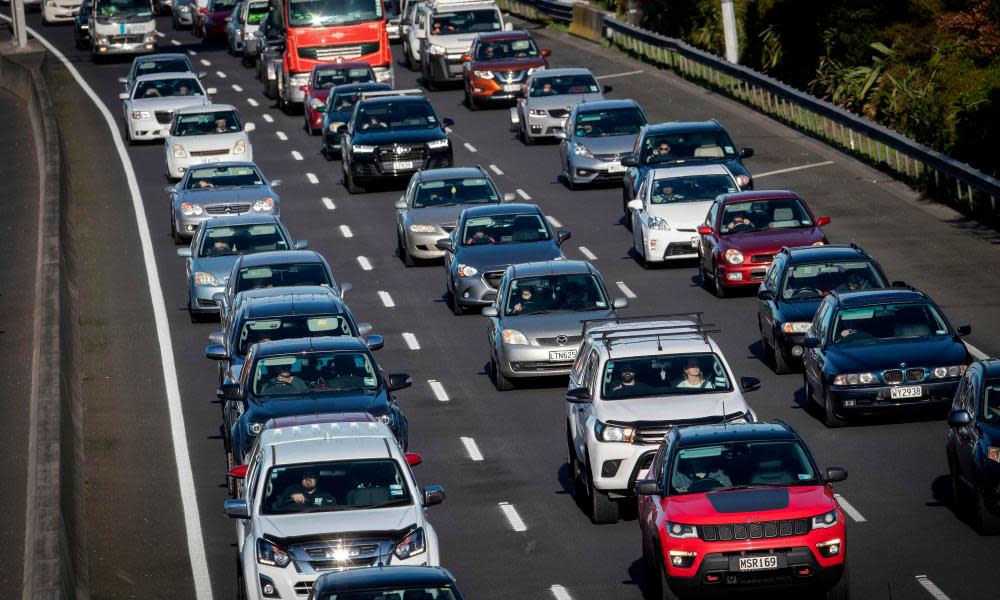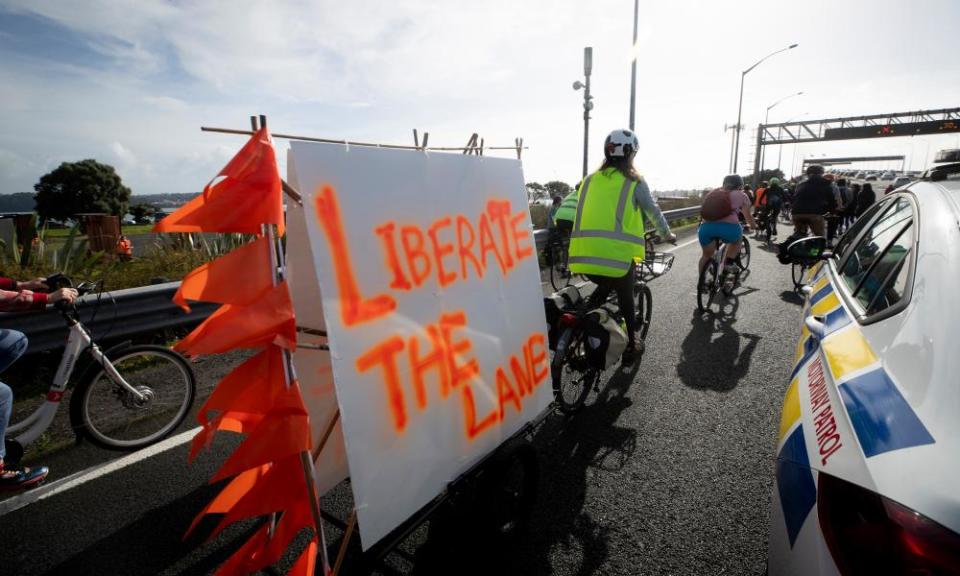‘People have an over-attachment to their cars’: where is Auckland transport going?

Auckland may have just won the title of world’s most liveable city thanks largely to New Zealand’s Covid-free status, but it’s not about to receive any traffic awards.
Aucklanders drove an average of 1.6bn kilometres a year more in 2017 than they did in 2013. Half of peak-time trips are under six kilometres. New Zealand has the fourth-highest per-capita car ownership in the world and Aucklanders own more cars per capita than ever before.The most recent New Zealand Health Survey reported that 83% of journeys to work were by car.
Transport planning for the future is urgent – Statistics NZ predicts that Auckland’s population will rise from 1.7 million to 2.4 million by 2046.
Related: 'Bulging at the seams': Auckland, a super city struggling with its own success
The congestion isn’t just about inconvenience and carbon emissions. A recent University of Auckland report found that driving was associated with psychological distress, particularly anxiety.
“Car trips can have quite a negative impact on people’s mental health, for the people taking the trip and for the neighbourhood that people take a trip through,” says the lead author of the report, Dr Kirsty Wild from the University of Auckland. She says that after just 15 minutes in a car “transport satisfaction” drops, and after 40 minutes “life satisfaction” drops.
Wild is especially concerned by the aggressive marketing of SUVs, which along with utes now constitute two-thirds of new vehicle sales in New Zealand.
“They’re marketed as safer but in fact they’re disastrous in terms of pedestrian safety,” she says. “They’re also not safer for people who drive them. Images of driving and freedom are heavily promoted. It’s our second largest advertising sector. We’re soaking in the idea that driving gives you control and freedom.”
We’re soaking in the idea that driving gives you control and freedom.
Kirsty Wild, University of Auckland
There are efforts underway to get New Zealanders out of their cars. In November 2020 there was a detailed multi-government department proposal for a congestion charge in Auckland that would see a cordon around the city centre at peak times. This could reduce traffic by 8%-12% – roughly school holiday levels – and would then be applied to key routes in the city’s wider road network.
Another scheme that will relieve traffic congestion is the $4.4bn City Rail Link project. Auckland’s first underground railway will allow the network to at least double rail capacity. Though it was scheduled to be completed by late 2024 it could now be delayed by new consultation plans for light rail to connect the city centre to Auckland airport, a project itself long delayed.
At the end of last month, Bike Auckland organised a rally calling on NZ Transport Agency (Waka Kotahi) to run a three-month trial this summer to convert one of the eight car lanes on the Auckland Harbour Bridge to a bike and walking lane. After years of frustration over a lack of progress about 1,500 cyclists broke through the police barriers to cycle over the bridge.
Days later, the transport minister, Michael Wood, announced plans for a new standalone bridge dedicated to walking and cycling to be built alongside the Harbour Bridge by 2026. Wood has also asked Waka Kotahi to draw up options for a cycling and walking lane on the Harbour Bridge now.

But Barb Cuthbert, chair of Bike Auckland, is unimpressed. “It’s a rerun of 2019 when Waka Kotahi produced alluring graphics without doing any design work,” she says. “Two years later they announced they couldn’t build the project.” She also claims that the trial lane is expected to be only for Sunday use.
“The reality is we’re not going to get anything on the bridge for another five years,” says Cuthbert. “What Auckland Transport have been doing is popping a bit of a cycle lane in a park and calling that 0.5km of cycleway. That is not a change agent. What really matters is a strategic cycle network.”
Problems of choice and over-attachment
Cuthbert says until there is real progress there will be more direct action as there has been in Wellington where unauthorised pop-up bike lanes put pressure on the council to fast-track cycleway projects.
Related: Auckland’s most liveable city status must be seen through prism of pandemic
There is some evidence that Aucklanders’ driving habits may be harder to shift even with an improved public transport network.
Dr Mohsen Mohammadzadeh, director of urban planning programme at the University of Auckland, undertook a study at Hobsonville Point in the city – the largest planned urban development in New Zealand – that found that even though it was designed to be close to public transport links, almost all of the residents still wanted to own their own car. Each house had two or three cars despite the single-car spaces allocated for each property.
Mohammadzadeh argues that New Zealand needs to change the socio-cultural values that decades of car ownership reflect.
“People have an over-attachment to their cars,” he says. “They perceive their car ownership to have a personal meaning. Parents are intentionally using their cars at school pickup time to show off their vehicles to other people. It’s the mentality we need to work on.”
But Kirsty Wild disagrees that it’s an entrenched cultural problem. “You cannot infer preference from current behaviour unless people have proper choice,” she says. “Walking, cycling and public transport are just not proper choices in Auckland. With cycling you’re asking people to risk their lives to do it – it’s not surprising that they don’t.”

 Yahoo Movies
Yahoo Movies 
